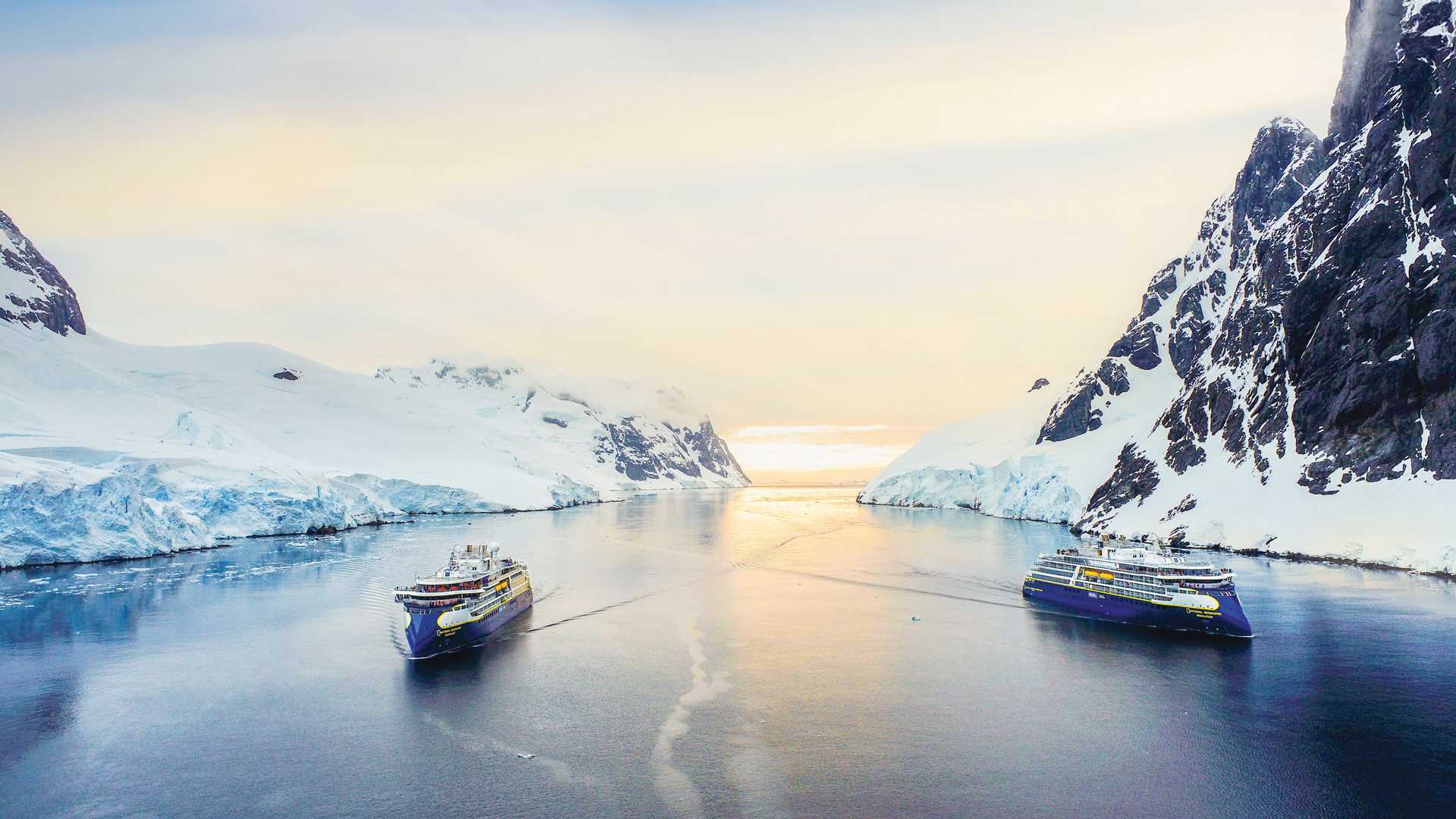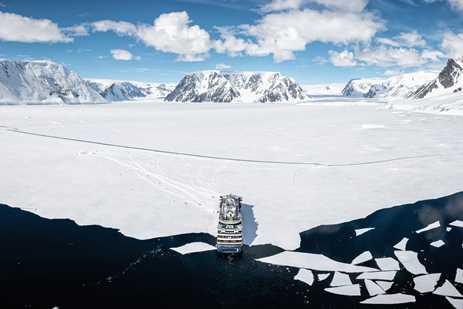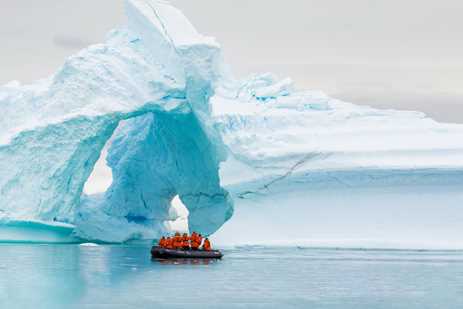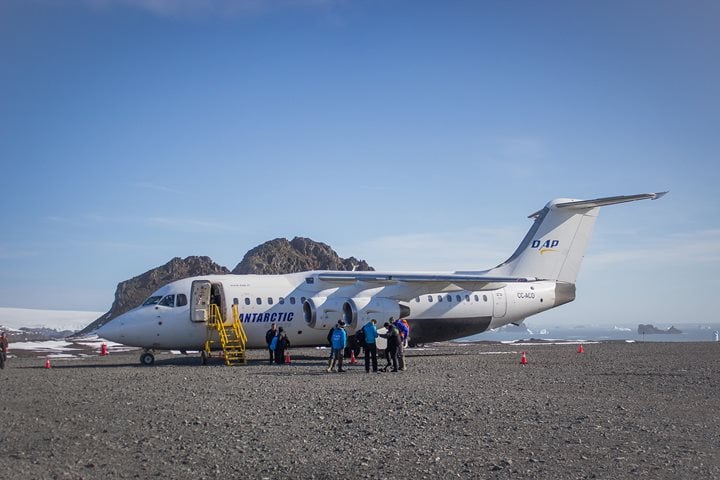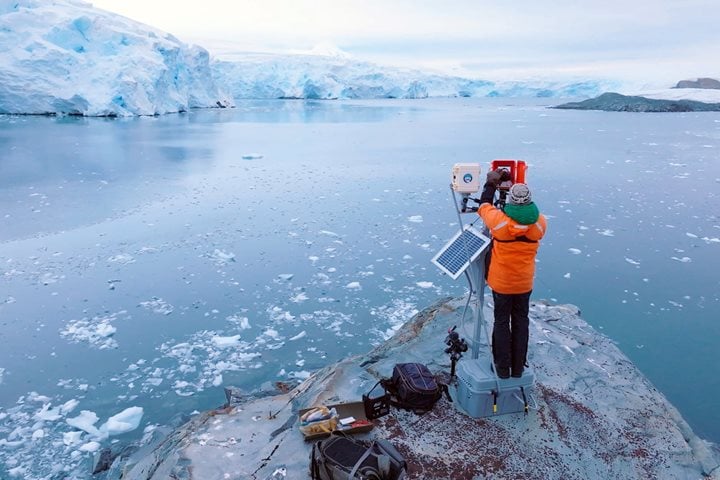Call +1.800.397.3348 or contact your travel advisor
The seventh continent is a 5.5-million-square-mile realm of ice and snow, with an otherworldly beauty that must be seen to be believed. In this polar kingdom penguins, seals, whales, and seabirds reign supreme, windblown plateaus teem with dramatic ice formations, and seracs calve into crystalline waters.
It’s also more accessible than you might think. Lindblad Expeditions pioneered travel to Antarctica in 1966 and has been bringing intrepid travelers into its icy wilds for more than five decades. With an expanding portfolio of Antarctic itineraries and state-of-the-art polar ships, travel to the bottom of the globe is more attainable than ever before.
As Susan Salvin, an expedition developer at National Geographic-Lindblad Expeditions explains, an Antarctic expedition is not only very doable but can also be “life-changing,” whether for the vastness of the scenery, the teeming and charismatic wildlife, or the clear, unfiltered sunlight of the 24-hour summer day. Here’s everything you need to know about getting to Antarctica.
Can You Travel to Antarctica?
Yes, you can travel to Antarctica, but you’ll need to go there with an expedition cruise company. Antarctica is managed jointly by more than 50 nations, with all private-sector travel overseen by the International Association of Antarctica Tour Operators (IAATO). IAATO guidelines dictate that travelers can only visit the continent with a sanctioned operator.
So, while you can realize your dreams of Antarctica travel, it will need to be with an IAATO member cruise line or outfitter. And although the answer to the question “Can you visit Antarctica?” is a resounding yes, it’s going to take an adventurous spirit on your part, as well as a dose of flexibility. That’s because the climate here is, well, Antarctic.
As Salvin emphasizes, all visitors to the seventh continent are at the mercy of the elements, whether it’s in transit across the exposed seas of the 500-mile Drake Passage or in Antarctica itself. Like any great adventure, you'll need to contend with Mother Nature, which means being able to adjust your goals and expectations day by day, and sometimes even hour by hour. Packing the right gear is also key to keeping you safe and comfortable.
How Do I Get to Antarctica?
Visiting Antarctica is first a matter of finding your way to the southern tip of South America—Chile or Argentina—from where cruise ships, expedition cruise ships, and passenger planes travel across the Drake Passage to either the continent itself or the outlying islands. A crossing in a cruise ship typically takes between a day and a half and two days, while a flight typically takes two hours.
The Antarctic travel season takes place from November to March which is the best time to visit the White Continent.
Visiting Antarctica by Plane
If you have limited time for a trip to Antarctica, or you’re worried about seasickness while crossing the Drake Passage, your best bet is a flight. Some expedition companies run planes out of Punta Arenas or Puerto Natales, Chile, flying from Presidente Carlos Ibáñez del Campo International Airport and landing at Teniente Rodolfo Marsh Martin Airport on King George Island, north of the mainland. From here, you can go to Antarctica itself via ship.
National Geographic-Lindblad Expeditions, for example, offers four options for flying the Drake Passage: an 8-day, 9-day, or 10-day expedition that takes you between Puerto Natales, Chile and King George Island via a two-hour charter flight, and a 10-day voyage that takes you from Ushuaia, Argentina to Antarctica by sea and brings you back to Puerto Natales by charter flight.
Visiting Antarctica by Expedition Ship
If you want to really get in and explore Antarctica firsthand, your best bet is an expedition ship. These smaller ships, with fewer guests, can be more flexible with their itineraries than larger cruise liners, angling into and debarking at the scenic bays, beaches, and inlets that the big ships just glide past, and letting you tackle a host of immersive, adventurous activities.
Your activities may vary depending on which company you choose for your Antarctica expedition cruise. Excursions could include anything from Zodiac cruises that bring you up close to wildlife, to hikes amid Antarctic mountains, or even spending a night camping ashore.
On a National Geographic-Lindblad Expeditions expedition cruise in Antarctica, you can take part in unique activities like kayaking among icebergs, cross-country skiing on frozen sea ice dusted by winter snow, or photographing the region’s iconic wildlife with help from a National Geographic Photography Expert.
Not surprisingly, an expedition cruise is considered one of the best ways to visit Antarctica.
Visiting Antarctica by Cruise Ship
If you’re more into socializing and onboard entertainment, an Antarctic cruise may be your preferred choice. Cruises to Antarctica often leave from big ports like Buenos Aires, Argentina, or San Antonio, Chile, then make their way south along the South American coastline before crossing the Drake Passage. These cruises typically last two-plus weeks, with ports-of-call in various towns and islands along the way, but no stopovers on Antarctica itself.
What to Know About Flights to Antarctica
Perhaps you’re curious about how to travel to Antarctica the quickest way or wondering if you can fly directly to the seventh continent. Unfortunately, flying to Antarctica is not as simple as hopping a flight to Las Vegas for the weekend.
In fact, there are no direct commercial flights, though charter flights will take you to nearby King George Island, and even the South Pole or other ice-strip runways on a ski-plane.
Can You Fly to Antarctica?
As we’ve mentioned above, you can fly to Antarctica on a chartered flight. The majority of flights across the Drake Passage leave from Punta Arenas, Chile, whereas expedition cruise ships typically leave from Ushuaia, Argentina.
Nearest Airport to Antarctica
The nearest airport to Antarctica is the Teniente Rodolfo Marsh Martin Airport (TNM) on King George Island, 75 miles north of the mainland in the South Shetland Islands, an Antarctic archipelago home to several polar research stations and the spectacular scenery Antarctica is famous for. Guests arriving here for expedition cruises are shuttled to their ship, where their Antarctic explorations can begin immediately upon arrival.
Airports in Antarctica
Antarctica itself does not have any commercial airports—the weather is too extreme, the ice too volatile, and the setting too remote. Instead, there are various small airstrips, many on the ice itself, including at research bases like McMurdo Station and the Amundsen-Scott South Pole Station, that can only be accessed by smaller, specialized ski-planes.
Flying Over the Drake Passage
For some guests, crossing the Drake Passage on a ship feels like a rite of passage, one that storied explorers have braved for centuries. However, the idea of sailing through potentially rough seas is not for everyone. Luckily, modern-day explorers have another option for crossing the Drake: a flight to Antarctica.
How Long is the Flight to Antarctica?
From Punta Arenas, Chile, the flight to King George Island, a typical launching point for Antarctica, takes roughly two hours.
Expedition Cruises to Antarctica
For aficionados of adventure travel, an expedition cruise is a great way to see Antarctica. These cruises take place on small ships that offer a range of travel amenities like fine dining and well-appointed cabins, but also the chance to experience the icy continent and its wonders firsthand.
Small ships, like the vessels in the National Geographic-Lindblad Expeditions fleet, offer the fullest experience because they have the fewest restrictions. Ships carrying 200 or more passengers are limited to certain sites, while ships carrying more than 500 passengers are restricted to ‘cruise only’ status with no landings.
What Is an Antarctic Expedition Cruise?
An expedition cruise takes you to the White Continent on a smaller ship, one in which the passenger manifest numbers in the low hundreds, not thousands, and the focus is on the opportunity for immersion in nature rather than on onboard entertainment.
For example, state-of-the-art sister ships National Geographic Endurance and National Geographic Resolution are two of the polar ships in the National Geographic-Lindblad Expeditions fleet. Each is a PC5 Category A icebreaker that can expertly cross the Drake Passage, ford ice-choked seas, and even park in the fast ice to let passengers descend onto the frozen sea to explore.
But these vessels also have myriad amenities and luxury cabins, with outward-facing views, for just 138 guests. One unique feature is the first-ever, ship-based, permanent polar-art exhibit, curated by Zaria Forman, a specialist in large-scale works that document climate change in the polar regions. You also can relax at the wellness center, with its saunas and sunny yoga room, or work out in the ship’s fully equipped gym.
Up on the Observation Deck, you’ll find twin infinity hot tubs and a pair of geodesic igloos, where you can spend a night under the bright southern stars in a plush bed warmed by hot-water bottles.
Why Choose an Expedition Cruise to Antarctica
If you value immersion and adventure over merely ticking off a “bucket-list” destination, then an expedition cruise will appeal to you. In Antarctica, this immersion means getting up close and personal with the region’s legendary wildlife, from orcas and leopard seals, to humpback and blue whales, to the boisterous penguin rookeries that line the shores—it’s like finding yourself in a real-life nature documentary.
Beyond the wildlife, you'll discover that Antarctica has much more to offer: the heroic history of its explorers—like Ernest Shackleton, who almost became the first to reach the South Pole, in 1907, on his Nimrod Expedition and whose battle to save himself and his men on a later expedition is the stuff of lore. There’s also the indescribable icescapes, the ethereal blues and whites of the icebergs, the midnight sun in high summer, photo ops everywhere you turn, and much more.
It’s an all-in experience, the kind that elevates a mere trip to an unforgettable lifetime journey. “When the ship is able to park in the fast ice and passengers are able to get off, that’s otherworldly,” says Salvin. “To be able to look back when you’re on the ice and see the vessel and how small it looks—that’s pretty incredible!”
The Downsides to an Antarctica Expedition Cruise
One downside to an expedition cruise to Antarctica is the higher cost compared to taking a larger cruise line. However, expedition cruise passengers get much more individual attention from staff: a ratio, of say, one staff member per every 13 passengers, versus one per hundreds. Read more about the cost of Antarctic cruises.
Expedition cruises are also typically less predictable in their itineraries, as the day’s destinations and activities depend on the weather and on where the smaller ships and Zodiacs can get to.
Photo: David Vargas
Luxury Antarctica Cruise Itineraries
Luxury Antarctic cruises prioritize comfort on board, with high-end amenities that may include multiple five-star dining venues, expansive spas, swimming pools, and large state rooms. They typically depart from Ushuaia, Argentina, cross the Drake Passage, and then spend anywhere from one to four weeks touring the Antarctic Peninsula and its environs.
National Geographic-Lindblad Expeditions cruises offer world-class amenities while also emphasizing the luxury of an exceptional—and supremely comfortable—experience in the wild. Unique features include a low staff-to-guest ratio, an open bridge policy, small ship capacities that foster a spirited camaraderie, and patented maritime technologies that maximize comfort in turbulent seas.
Where Do Expedition Cruises to Antarctica Leave From?
Most expedition cruises to Antarctica leave from Ushuaia, Argentina, which has a port large enough to accommodate the icebreaker ships that can navigate the pack ice. Port Ushuaia’s passenger terminal is located just 3.5 miles from Ushuaia’s Malvinas Argentinas International Airport (USH) in this stunning city of 60,000 people that marks the southern terminus of the Pan-American Highway.
Large Cruise Ships to Antarctica
A cruise on a large ship will enable you to visit Antarctica and potentially see its maritime wonders from the ship’s deck while still having all the social and entertainment amenities of your typical cruise.
Why Choose a Traditional Cruise Operator to Antarctica
You might choose a traditional cruise to the seventh continent if you’re traveling with family, children, or a large group with different interests and needs, and for whom the usual onboard cruise attractions—swimming pools, hot tubs, nightly entertainment, climbing walls, spas, casinos, and shopping to name a few—are an important part of the travel experience.
The Downsides to a Large Cruise Ship in Antarctica
The downside to being on these big boats, which are built to carry thousands of passengers, is that their massive size prevents them from docking anywhere other than the largest ports. In a remote place like Antarctica, this means having to sail right by the iceberg-laden coves, inlets, and other natural attractions that smaller expedition ships can nimbly access. Passengers on these larger boats are unable to get off and experience the wonders up-close.
Where Do Cruises to Antarctica Leave From?
Cruise ships to Antarctica typically leave from either Buenos Aires, Argentina, or San Antonio, Chile. In Buenos Aires, the passenger-ship port is the Terminal de Pasajeros Benito Quinquela Martin, four miles from the Aeroparque Jorge Newbery (AEP), where international flights come in. In Chile, boats leave from the port city of San Antonio, Valparaíso, which is 72 miles from Santiago and its Presidente Carlos Ibáñez International Airport (PUQ); the passenger terminal at the port is the Valparaíso Terminal de Pasajeros, or VTP.
How to Get to Antarctica from Where You Are
Unless you already live in southern Chile or Argentina, visiting Antarctica will first involve significant air travel to South America’s southern tip. It’s here, in the port city of Ushuaia, Argentina, that expedition cruise ships typically set out into the Drake Passage, or that plane tours depart from Punta Arenas, Chile.
To break up your journey, Salvin advises you to fly in a day early. “This gives you more time to get acclimated from the long trip and to make sure you have your luggage,” she says. Plus, Buenos Aires and Santiago are sightseeing capitals in their own right. Don't forget to pack your passport and other important travel documents!
How to Get to Antarctica from the USA
From the United States, the major airlines Aerolíneas Argentinas, American, Copa, Delta, LATAM, and United all operate daily nonstop flights to Buenos Aires, Argentina.
Flights originate in major U.S. airports, including Atlanta, Dallas, Houston, Los Angeles, Miami, and New York. Getting to Ushuaia via Buenos Aires involves a 3.5-hour direct flight from the city’s main airport, Aeroparque Jorge Newbery (AEP), on LATAM or Aerolíneas Argentinas.
Alternatively, you can travel to Punta Arenas, Chile, a typical launch point for the two-hour flight to Antarctica.
From the United States, the major airlines Avianca, American, Copa, Delta, LATAM, and United all operate daily nonstop flights to Santiago, Chile, with flights out of major airports including Atlanta, Houston, Miami, and New York. Getting to Punta Arenas via Santiago involves a six-hour nonstop flight from Santiago’s Presidente Carlos Ibáñez International Airport (PUQ) on JetSMART, LATAM, or Sky Airline.
If you travel aboard a Lindblad-National Geographic expedition to Antarctica, you'll find it's a seamless process, as all of your travel details will be handled accordingly. The air department can help you book your flights to Miami and then on to Santiago or Buenos Aires. From there, a chartered flight takes you directly to Ushuaia where you'll embark the ship.
How to Get to Antarctica from Australia
From Australia, the only airline with direct service to South America is Qantas, which flies from Sydney or Melbourne into Santiago, Chile. On LATAM, you can fly from Sydney to Santiago—with a stop in Auckland, New Zealand.
Getting to Punta Arenas via Santiago involves a six-hour nonstop flight from Santiago’s Presidente Carlos Ibáñez International Airport (PUQ) on JetSMART, LATAM, or Sky Airline. Punta Arenas is a typical launch point for the two-hour flight-cruises to Antarctica, if you prefer to skip crossing the Drake Passage via ship.
If you’ll be visiting Antarctica via expedition cruise, then you’ll most likely make your way to Ushuaia, Argentina, via Buenos Aires (a two-hour direct flight from Santiago, if say, you flew into the latter city on Qantas or LATAM).
Getting to Ushuaia via Buenos Aires involves a 3.5-hour direct flight from Buenos Aires’ main airport, Aeroparque Jorge Newbery (AEP), on LATAM or Aerolíneas Argentinas.
How to Get to Antarctica from the UK
From the United Kingdom, there are daily flights to Buenos Aires, Argentina, leaving out of London on Aerolíneas Argentinas, Azul, British Airways, Delta, easyJET, KLM, LATAM, Lufthansa, and Ryanair. From there, getting to Ushuaia via Buenos Aires involves a 3.5-hour direct flight from Buenos Aires’s main airport, Aeroparque Jorge Newbery (AEP), on LATAM or Aerolíneas Argentinas.
You can also travel to Punta Arenas, Chile, a typical launch point for the two-hour flight-cruises to Antarctica. From London, the major airlines Avianca, easyJet, LATAM, Ryanair, and Sky Airline operate daily flights to Santiago, Chile.
Getting to Punta Arenas via Santiago involves a six-hour nonstop flight from Santiago’s Presidente Carlos Ibáñez International Airport (PUQ) on JetSMART, LATAM, or Sky Airline.
How to Get to Antarctica from Canada
From Canada, a long (13- to 16-hour) one-stop flight from Montreal, Vancouver, or Toronto on Air Canada will get you to Buenos Aires, Argentina. There are also other options on Aeromexico, American, Delta, LATAM, and United.
Getting to Ushuaia via Buenos Aires involves a 3.5-hour direct flight from Buenos Aires’s main airport, Aeroparque Jorge Newbery (AEP), on LATAM or Aerolíneas Argentinas.
You might also travel to Punta Arenas, Chile, a typical launch point for the two-hour flight-cruises to Antarctica that bypass the ship crossing of the Drake Passage.
From Canada, the airlines Aeromexico, American, Avianca, Copa, Delta, LATAM, and United all run flights to Santiago, Chile, from Toronto. Getting to Punta Arenas via Santiago involves a six-hour nonstop flight from Presidente Carlos Ibáñez International Airport (PUQ) on JetSMART, LATAM, or Sky Airline.
When it comes to an expedition cruise to Antarctica, “the best thing to pack is your sense of adventure and flexibility,” says Salvin. “If you come in with an open mind, anything and everything that happens is going to be a positive. Truly, it’s an expedition—it’s not mapped out! That’s the sense of adventure.”
While an expedition cruise to Antarctica is somewhat costly and requires committed long-haul travel to reach your embarkation point, ask anyone who has been and they’re sure to tell you it’s a life-changing journey you’ll never forget. Aboard these nimble, small ships, you’ll encounter myriad wonders up-close that can’t be witnessed anywhere else on Earth, and return home with a new perspective on our extraordinary and precious planet.

